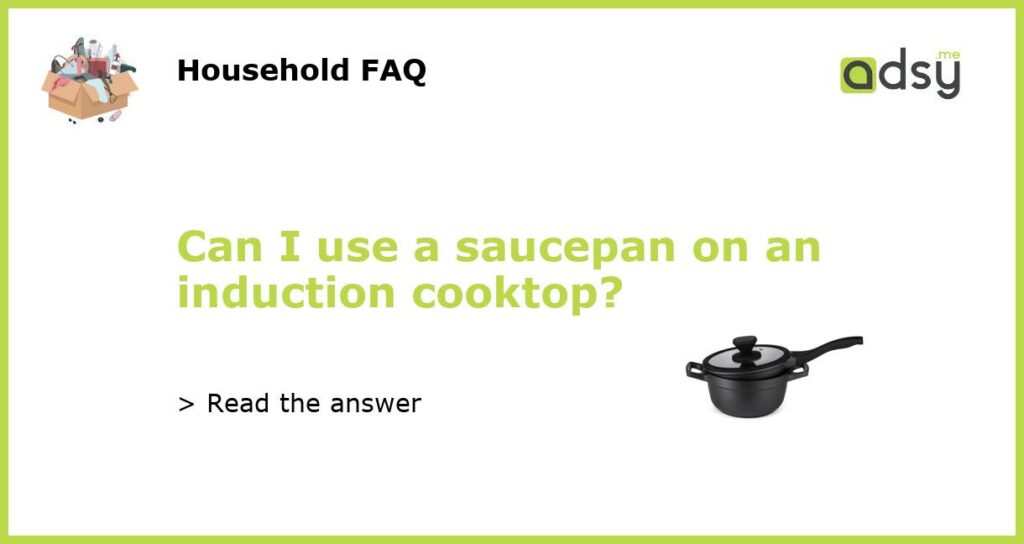Yes, you can use a saucepan on an induction cooktop
Induction cooktops have become increasingly popular in recent years due to their fast cooking times, precise temperature control, and energy efficiency. However, many people wonder whether they can still use their trusty saucepans on an induction cooktop. The good news is that, in most cases, you can indeed use a saucepan on an induction cooktop. However, there are a few things you need to keep in mind to ensure safe and effective cooking.
How do induction cooktops work?
Before we delve into whether you can use a saucepan on an induction cooktop, let’s first understand how induction cooktops work. Unlike traditional gas or electric cooktops that heat the surrounding air or the cookware directly, induction cooktops use electromagnetic currents to heat the cookware itself. These currents are generated by a coil of copper wire located below the surface of the cooktop. When an induction-compatible cookware is placed on the cooktop, the magnetic field generated by the coil induces an electric current in the cookware, resulting in heat.
Choosing the right saucepan for an induction cooktop
Not all saucepans are compatible with induction cooktops. To use a saucepan on an induction cooktop, you need to ensure that the cookware is made of a magnetic material, such as cast iron or stainless steel. These materials allow the electromagnetic currents to pass through and generate heat. Aluminum, copper, and glass cookware, on the other hand, are not induction-compatible and will not work on an induction cooktop. To check if your saucepan is suitable for induction cooking, simply hold a magnet to the bottom of the pan. If it sticks, your saucepan is induction-compatible.
Using a saucepan on an induction cooktop
Once you have confirmed that your saucepan is compatible with induction cooking, you can use it on an induction cooktop just like you would on a gas or electric cooktop. However, there are a few important points to keep in mind:
1. Ensure the base of the saucepan is clean and dry: Any residue or moisture on the bottom of the pan can affect the efficiency of the electromagnetic currents and lead to uneven heating.
2. Place the saucepan centered on the cooking zone: Induction cooktops are typically divided into cooking zones, and each zone has a specific size. Make sure that your saucepan is centered on the cooking zone so that the induction coil can generate heat evenly across the base of the pan.
3. Use the right size saucepan for the cooking zone: The size of the saucepan should match the size of the cooking zone. Using a smaller saucepan on a larger cooking zone may result in inefficient heating, while using a larger saucepan on a smaller cooking zone can lead to heat loss.
Maintaining your saucepan and induction cooktop
To ensure the longevity of both your saucepan and induction cooktop, it’s important to follow proper maintenance practices:
1. Clean your saucepan properly: Avoid using abrasive cleaning agents or scrub brushes that can scratch the surface of the saucepan. Instead, use a soft sponge or cloth and mild dish soap to clean the saucepan.
2. Avoid dragging the saucepan on the cooktop surface: Induction cooktops have a smooth glass surface that can easily scratch. To avoid damaging the cooktop, lift the saucepan instead of dragging it.
3. Regularly clean the induction cooktop: Wipe the cooktop with a soft, damp cloth after each use to remove any residue or spills. Avoid using harsh chemicals or abrasive cleaners that can damage the glass surface.
The bottom line
In conclusion, you can use a saucepan on an induction cooktop as long as the saucepan is made of a magnetic material, such as stainless steel or cast iron. Ensure the saucepan is clean, dry, and centered on the cooking zone for optimal heat transfer. Follow proper maintenance practices to preserve the life of both your saucepan and induction cooktop. By following these guidelines, you can enjoy the benefits of fast and efficient cooking with your saucepans on an induction cooktop.






